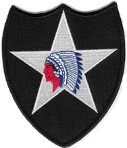
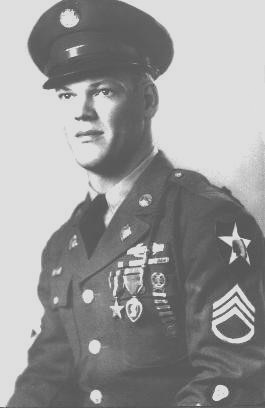
Note: Hanford M. Rice was a Staff Sergeant (in combat infantry) in the 1st Battalion of the
U.S. 9th Infantry Regiment of the U.S. 2nd Infantry Division during World War Two.
He wrote a diary that I think is interesting. Since he was my father I now quote it in it's
entirety. This info might be useful to anyone wanting to trace the combat activity of the
1st Battalion. He was an infantryman in Charlie Company. His military nick name was "China Boy."
He landed on Omaha Beach on D Day + 1. It is not a complete history, however, as he was wounded just
before the Battle of the Bulge and so his military story ends there.
His war diary is combined here with his regimental history and with his division history.
In other words, to make his war diary more interesting I have quoted the official battle history of the
U.S. 2nd Infantry Division as well as the official history of his U.S. 9th Infantry Regiment.
Each history was written and printed in 1945. Each battle listed below is color coded:
The Division history is shown here in blue print
The Regimental history is shown here in green print
His diary is shown here in brown print

U.S. 2nd Infantry Division Battles and Campaigns in WW2: |
Normandy | Northern France | Rhineland | Ardennes | Central Europe |

Hitting Omaha Beach on D-Day + 1
"D plus 1, June 7, 1944: in the teeth of vicious, accurate enemy shellfire which blanketed
the shoreline, the Indian Head boys hit the beach at St. Laurent-sur-Mer. Preassigned
assembly areas, when eventually located in the confusion of battle, were packed with
snipers. Before moving in, one regiment was forced to blast out a company of Germans.
Vehicles, infantry supporting weapons and communications equipment remained aboard craft off
the beach. Three days were to pass before these vital supplies began rolling inland.
Communications were established with salvaged wire found on the beach and abandoned enemy
equipment. The only vehicle in the division was a jeep loaned by another unit to Division
Commander Major General Walter M. Robertson.
By midnight, the CP (command post) had been established and assembly areas largely cleared
of enemy. The silence of darkness was shattered by heavy anti-aircraft fire when German
planes zoomed overhead. The division staff already had planned the attack on the first
objective, Trevieres, a communications center 16 kilometers inland. Field orders were
scrawled in longhand on German stationery.
Near midnight, June 8, the last infantry regiment began to unload and a staff officer
reported to headquarters that the unit was ready to move to an area previously selected.
He was told that the area, far in advance, had not been cleared according to plan- that it
now was occupied.
"On June 7, 1944 - D Day plus 1 - the Regiment's greatest mission began when it landed on
Omaha Beach in Normandy with the Allied invasion forces."
June 6, 1944: "D Day. On the boat heading for France."
"Although lacking supporting weapons and communications, one regiment attacked the strongly
defended town of Trevieres June 9. Knowing that the infantry possessed only the minimum
of necessary transportation, the artillery pumped in shell after shell. Battle plans called
for the regiment's second battalion to approach from the north, while the third battalion was
to cross the Aure River and flank the objective from the west. A second regiment was to
attack on the east. Trevieres was defended by an infantry battalion which had been ordered
to fight to the last man.
After the jump-off, one platoon got inside the city. Heavy sniper and automatic weapons
fire held up the other attackers. The third battalion waded the waist-deep river, stormed
the defenses to the south, then smacked the enemy from the west flank of the town. So
tenacious was the German grip that the objective was not entirely outflanked and secured
until the next day.
Only a limited number of hand grenades was available. Not until the closing stages of the
battle were machine guns brought up from the beach area. To replenish the meager supply of
ammunition, a French two-wheel cart was commandeered. But the ammunition still had to be
hand-carried across the river. Wounded were hand-carried on the return trip across the stream.
One officer and six men were pinned inside a house four hours during the first day of the
fierce assault. They were armed only with pistols and carbines while Germans were within
grenade-throwing range on three sides.
Liberation of Trevieres marked the fall of the first major obstacle as the expansion of the
V Corps bridge-head struggled forward."
June 7, 1944: "Landed in France. Went into action. Guarded regular (Command Post) CP. Scared to death.
Bodies on the beach everywhere."
June 8, 1944: "1st and 2nd battalions went sniper hunting. Lt. Graham and Sgt. Clark
killed by an S mine. Lt. Woodbury wounded. Still guarding regular CP. Rejoined my
company at night. Jerry airplanes came over. It was a swell show."
June 9, 1944: "2nd and 3rd battalions attacked. Went through Cerissy Forest. Captured
an ammo dump. Hiked 20 miles."
June 10, 1944: "We mounted on tanks. Captured 2 prisoners and killed 2 Jerries and
one officer."
The Attack Through the Cerisy Forest
"The push neither stopped nor hesitated at Trevieres. Spearheaded by the 9th and 38th
A well-defined German defense line was struck June 11 in the Berigny-St. Georges d'Elle-Ivon
sector. Here, the "Second to None" had its first encounter with the 3rd Parachute Division
of the Wehrmacht, took its first prisoners. It was the beginning of a grudge-fight which
was to be renewed many times- much to the sorrow of the paratroopers. Between then and
June 16 when a halt was ordered to prepare for the attack on Hill 192, the division's
tentacles wound around nearby villages and consolidated gains. St. Georges d'Elle, the
town that was to change hands several times, was entered by battalions of the 23rd and
38th Regiments. The 23rd also captured Berigny, while St. Germain d'Elle fell to the 9th.
Fighting throughout this sector was fierce. The battle of the hedgerows was on- and with all
the stops out. Mounds of earth, sometimes as wide as three feet and almost as high as a
man's head, divided the fields. Behind and between these the Germans dug in and waited to
spray machine gun and automatic weapon fire on the first American to step into the field.
Most fields were no larger than a house lot back home. Sunken roads wove in and out of the
fields, providing excellent enemy cover."
June 11, 1944 (Sunday): "Attacked and gained Powder Keg Hill. Lt. Day hit. (A German)
armoured car wounded several (Americans) and then got away."
June 13, 1944 (Tuesday): "Still holding and guarding machine gun section. (I Am)
Learning a few words of French."
June 14, 1944 (Wednesday): "We can write mail for the first time in France. Still
holding (the line). (The rest of the 9th inf.) Regiment caught up (to us)."
June 15, 1944 (Thursday): "Still holding Powder Keg Hill. (Our)Third squad (is now)
guarding (our) machine gun section. 3 Jerries got away. Killed a horse."
June 16, 1944 (Friday): "(We) Left Powder Keg Hill. Attacked Purple Heart Valley.
Cowboy, Escalera, and Gonzales were killed. (Cleo) Morse (got) wounded. Got relieved
by the 1st Division."
June 17, 1944 (Saturday): "I am First Squad leader. It rained all day. We are (resting)
in the (2ID) reserve (area)."
June 18, 1944 (Sunday): "Valuenuzla shot himself. Cobb made platoon sergeant. I made staff
sergeant. (Charles) Stratton came over. 3 Jerry airplanes came over and 2 (of these were)
shot down. I got in a hornet's nest."
June 19, 1944 (Monday): "Still in reserve. Relieved the Second Battalion at night.
All drunk. The bazooka men got lost. Hobbs and a recruit mix it up (get in a fight)."
The Battle for St. Germain d'Elle
"In the battle for St. Germain d'Elle, fighting grew extremely severe. Casualty lists mounted
steadily. One company lost 17 men one day, 15 the next. A company commander told of knocking
out seven machine guns in one field and five in another only to have them replaced from a
seemingly endless chain.
During the entire struggle which preceded the smashing of the forces defending Hill 192,
artillery played an important role in holding the Nazis inside holes they had lined along
hedgerows. The design was to bring down surprise mass fire on every possible position.
That this "time-on-target" firing, in which shells from multiple guns were timed to rock
objectives simultaneously, had the desired effect was attested to by patrols. At any minute,
a barrage would batter a position. The Germans quickly learned to crouch in their holes.
Once, when an infantry regiment was staving off a counter-attack, an artillery liaison
officer hurriedly called back for fire. Asked the nature of the target, he replied:
"Call it machine guns, call it tanks, call it anything. Just give me fire". He got it-
from four battalions- and in time.
In the fight for St. Georges d'Elle, Pfc Ralston A. Shepherd, 23rd Inf., saved three companies
from mass slaughter. Cornered in an area 30 by 100 yards, with hedgerows skirting both
sides, the companies lay in direct line of fire from a flak gun. Shepherd placed his
Browning Automatic Rifle (BAR) over a gate post and fired more than 1,000 rounds, dispersing
the Nazis gun crew before it had the opportunity to go into action. The companies took
advantage of the precious time, reorganized and fought their way out of the trap. For his
action, Shepherd was awarded the Silver Star.
There were many such heroes. Private Joe Marez, an aid man with the 9th Regiment, disregarded
a hail of machine gun and rifle fire during an attack when he ran forward to attend two
wounded riflemen. As he applied a tourniquet to the first man's leg, a bullet struck his
head. But Marez didn't quit. He started for the second man, then suddenly collapsed. He was
evacuated just in time to save his life. For his heroism, Marez got the division's first
Distinguished Service Cross (DSC).
There was one corporal of the 38th Inf. Regt. who was wounded and couldn't be evacuated.
When German forces advanced near his position, the corporal, unable to stand, pulled a gas
protective covering over his body for camouflage and began sniping at them. Although without
food, he kept this up for two and a half days until relief finally came. The bodies of two
Germans he had killed and the bloodstains of one he had wounded during this time were found.
It was during this fighting, in which green troops came to grips with seasoned German
soldiers for the first time, that "88 Corner" became the best-known crossroad in the area.
German artillery had zeroed in on the much-used intersection of the St. Lo - Cerisy La Foret
roads. A day never passed without shells landing nearby. Division Military Police (MPs)
constantly braved the fire to direct traffic."
June 20, 1944 (Tuesday): "We find our positions. Get straightened out and dig in deeper."
June 21, 1944 (Wednesday): "We hold for 15 days."
June 22, 1944 (Thursday): "We patrol at night. We have an OP (observation post) three
hedgerows in front of our lines."
June 23, 1944 (Friday): "Still patrolling. (Enemy) mortar and artillery falling heavy."
June 24, 1944 (Saturday): "Doc Knelby joined the third platoon. We got some chickens
and fried spuds (potatoes) and onions. Our poney stays with us."
June 25, 1944 (Sunday): "Still five miles north of St. Lo."
June 27, 1944 (Tuesday): "Sgt. Storey came in with the kitchen, so I got hot coffee
and biscuits."
June 28, 1944(Wednesday): No entry in his diary on this date.
June 29, 1944 (Thursday): "(Another American soldier with the same last name of) Rice
was killed on patrol. Everyone thought it was me."
June 30, 1944 (Friday): "Amacher gets hit in his rear end. Our poney got shot because
he would not halt."
July 1, 1944 (Saturday): "Sgt. League hit with scrapnel. We could sure use some rest."
July 2, 1944 (Sunday): "Still holding."
July 3, 1944 (Monday): "Still holding."
July 4, 1944 (Tuesday): "To celebrate the fourth of July each gun in the U.S. army
fires one round at twelve o'clock. It was a real celebration."
July 5, 1944 (Wednesday): "We go to the division's reserve area. 3rd Battalion
relieves us. Everything smooth sailing."
July 6, 1944 (Thursday): "We have training with tanks. Weather is warmer."
July 7, 1944 (Friday): "Hill (192 is) another problem and it sure is hot. We move out
to eighty eight corner on the road block."
July 8, 1944 (Saturday): "One hill separates us from St. Lo."
July 9, 1944 (Sunday): "Sweating out 88s (enemy artillery)."
July 10, 1944 (Monday): "Sweating out 88s (enemy artillery). (William F.) Parker
was hit with scrapnel."
The Battle for Hill 192
"Hill 192 was a grassy slope occupied by the enemy. It had to be taken because it was
holding up the advance on the town of St. Lo.
The battle for Hill 192, vital strongpoint on the way to St. Lo, was next. One rifle company
succeeded in reaching the crest June 16 only to be driven back in the face of a withering
counter-attack. The division's 2nd Engineers Combat Battalion hurriedly was rushed up to
fight as infantrymen.
From then until July 11, when the Indian Head boys roared to success on the heels of a
tremendous artillery and aerial bombardment, the division got ready for more of the same.
Thickly covered with heavy foliage, the hill commanded a six-mile area. When "Second to
None" wrested the precious territory from the Nazis, the breakthrough at St. Lo, vital
communications center just six miles away, was set to follow two weeks later.
The enemy had been fortifying Hill 192 for months. It was studded with foxholes, machine gun
nests and expertly camouflaged observation points. Hedgerows sprouted along its gradual
slope. Behind these, Germans huddled in dugouts.
Every crossing and road in the vicinity had been zeroed in by enemy artillery emplaced on the
rear slope. German camouflage suits blended softly with the foliage so well that one Nazi
sniper remained in a tree only 150 yards from American lines an entire day before he was
located and killed.
Here, T/Sgt. Frank Kviatek gained fame for his skill at picking off snipers. A veteran of 27
years in the army, Kviatek used a bolt action Springfield with telescopic sight to account
for 21 Germans, mostly snipers. His goal was 25 for each of two brothers killed in Italy.
Later wounded, he returned to combat to boost his total to 36.
Opposing forces were so close together at this stage of the struggle that infantrymen
propelled hand grenades with slingshots made from abandoned intertubes.
In one raid preparatory to the drive over the hill, 1st Lt. Ralph Winstead, 38th Infantry,
led a combat patrol that blasted its way through enemy hedgerow positions and killed or
seriously wounded at least 11 Nazis. With clock-like precision, the patrol poured through
three holes cut out of the hedgerow by engineers before returning to their lines. Every
member of the 16-man raiding party received either the Silver or Bronze Star (for bravery
under fire). Only one man was seriously wounded.
The taking of Hill 192 finally was achieved through coordinated efforts of infantry,
artillery, tanks and engineers. The Air Force also helped by softening up the heights with
dive-bombings. Simultaneously with the main assault, the 9th Regiment on the left flank
executed a diversionary attack to mask the action that was to take place on a division front.
Shortly before daybreak, July 11, eight battalions of division and corps artillery laid down
a heavy concentration which shifted to a rolling barrage as the attack knifed forward.
Artillery shells screamed and shook the earth until the objective was secured that
afternoon. Many Germans who surrendered had been dazed by the intensity of the shell fire.
They admitted it was worse than fighting on the Russian front.
Meanwhile, engineers blasted holes in the hedgerows through which tanks rumbled to spray
the next hedgerow with cannon and machine gun fire. This kept the Nazis down until
infantry, following behind the tanks, could pick off or capture them. Tank dozers, their
mammoth scoops poised in front, filled in sunken roads or ploughed over machine gun nests.
One dozer operator, Pvt. John R. Brewer, 741st Tank Battalion, saw three Germans behind a
hedgerow blazing away at the advancing troops with their burp guns. He smashed the hedge
over the trio, burying them alive.
Although tanks and artillery were of inestimable value, it was the doughboys who captured
Hill 192- advancing yard by yard up the slopes, digging the Germans out of the shelters as
they came to them.
Second Lt. Mac L. Basham, 38th Inf., reported he routed one Nazi from his hole and then made
the Kraut accompany him to other shelters to order out his comrades. After taking seven
prisoners this way, the Lieutenant turned them in, secured the aid of two enlisted men and
together they drove five more from dugouts.
By late afternoon, "The Hill" belonged to the men of the 2nd. The division, its immediate
mission accomplished, faced south to await the great breakthrough."
July 11, 1944 (Tuesday): "Holding the road block. 400 pound T.N.T. crater charge."
"Then the 9th Regiment participated in the July break-through operations, driving south
from Saint Germain and crossing the Vire River in heavy fighting."
July 26,1944 (Wednesday):”We attacked on a large scale. (My company) Charlie company is in reserve. (Ernesto) Elizondo was killed that night. (Edwin O.) Urbat, (Grady W.) Patterson, (Joseph T. Haughney) “Hoff”, (Sgt. August) Pilsner were killed. Artillery was hitting all around.”
July 27, 1944 (Thursday): “Company C attacked at 1830 (6:30 p.m.) between A and B companies. We lost 45 men. We were pinned down by machine gun fire. We lost 3 tanks and Wakefield, (Leonardo) Castillo, (Alvin O.) Larson, and Rowe also. Then we were relieved by the 5th Division.”
July 28, 1944 (Friday): “Hiked all night. Ate chow. Attacked at 1000 hours (10 a.m.). We passed the 23rd regiment. (We) captured enemy weapons.”
July 29, 1944 (Saturday): “(We) Stayed there all day. Jerry shot down one of our planes.”
July 30,1944 (Sunday): “(We) Attacked all day. I have had very little rest. We lost 40 men (including) Captain Algers, Cobb, and Crumbly. (Our) first platoon was all shot up. The 2nd battalion relieved us. We only have 85 men and 2 officers left.”
July 31,1944 (Monday): “(We) Attacked all day and kept going at night (time). Crossed the railroad (tracks).”
August 1, 1944 (Tuesday): “(We) Attacked all day. Houses were burning. The local people lived in caves and gave us flowers and also milk.”
August 2, 1944 (Wednesday): "Crossed the (Vire) River. (We) held our (combat) line.
A Jerry pill-roller (medic) gave himself up with two wounded."
August 3, 1944 (Thursday): "We attacked (again). Five men dropped out with combat fatigue.
Stethem left so I took the 3rd platoon. (Enemy) artillery is falling like rain drops.
(Those hit were) Captain Harvey, (Ed T.) Nisk, Kelly, (Robt. L.) Perkins,
(Elgin L.G. Bauer) Bower, Storey. (There are only) 16 men left in the 3rd platoon."
August 4, 1944 (Friday): "The 38th Regiment relieved us. We went back (to the division’s
reserve area) for rest. The kitchen came up."
August 6, 1944 (Sunday): "(Went to the) USO show. (They had) Red Cross girls there and
coffee and doughnuts. I had a quart of quantro. Got organized."
August 7, 1944 (Monday): "Rolled our rolls. Moved toward Vire. (We) passed our old
positions with the ammunition dump."
The Battle for Tinchebray
"August 15 saw the infantry slam into Tinchebray and advance to the outskirts of the far side
to guard against possible counter-attack. Next day, the division drew out of action and for
the first time in the battle of the hedgerows, the 2nd no longer had the enemy to its front.
It had come 40 kilometers in 20 days. The breathing spell came none too soon.
Almost immediately after the fall of Tinchebray, the 2nd embarked on a 300-mile journey
and the Battle of Brest."
August 8, 1944 (Tuesday): "Still holding at Vire. Digging in deeper. I am still the
platoon sergeant. Sergeant Morse goes to the 2nd platoon."
August 9, 1944 (Wednesday): "(We are) north of Vire. Hiked 10 miles to (new) positions."
August 10, 1944 (Thursday): "(We are) north of Vire. Holding the line in case of counter
attack."
August 11, 1944 (Friday): "(Our) forward outpost contacted the British. (We) found
lots of German weapons on a hill. (We) relieved the 2nd Battalion. Norce hit."
August 12, 1944 (Saturday): "(Our) 1st Battalion attacked. (We) captured 500 prisoners.
A (German) command car (was destroyed). (It is my) wife’s birthday."
August 13, 1944 (Sunday): "Holding the line."
August 14, 1944 (Monday): "Holding the line. Got paid. Sent home $80.00. (I had) steak
for dinner."
August 15, 1944 (Tuesday): "Holding the line at Vire. Took showers. (Today is the
day of the) invasion of southern France. Hit (the) spearhead."
August 16, 1944 (Wednesday): "Taking it easy- eating and sleeping. Sweating out the
division getting relieved or motorized (which will mean more combat for me)."
August 17, 1944 (Thursday): "USO show. Dinah Shore sang. Taking it easy."
August 18, 1944 (Friday): "Getting ready to move to Brest. We ride all night.
27 men in (the) truck."
August 19, 1944 (Saturday): “We unloaded off of trucks at eleven o’clock (11:00 am).
Pitched tent. Bought eggs. (We are) 12 miles from Brest.”
August 20, 1944 (Sunday): “We moved to the airfield. (We) relieved the 8th Division in
pill boxes. Raining cats and dogs.”
Note: there was a black and white movie produced in 1950 titled Breakthrough that
highlighted the U.S. infantryman's fight through the Normany hedgerows shortly
after D-Day. It stared the U.S. first infantry division- that division was on the left
flank of our second division at that time in Normandy. I mention this so you can have
an opportunity to see what hedgerow fighting was like in Normandy at that time. It stars
David Brian, John Agar, and Frank Lovejoy. I know
my father hated fighting in those hedgerows and talked about them much of the time
after the war. I have this movie on dvd and I recommend that you purchase it from
someone who has it for sale. It is a part of the Warner Brothers archive collection.
 Snipers remaining in the area were killed the next day and, at one time, a fusillade of
sniper bullets spattered into the division CP. One sniper was shot down from a tree some
50 yards away from division headquarters.
Snipers remaining in the area were killed the next day and, at one time, a fusillade of
sniper bullets spattered into the division CP. One sniper was shot down from a tree some
50 yards away from division headquarters.
"By whom?" he asked.
"By the 353rd Infantry Division", was the reply.
"Never heard of them, sir. Who are they?"
"Germans".
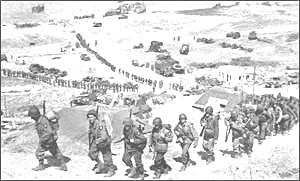
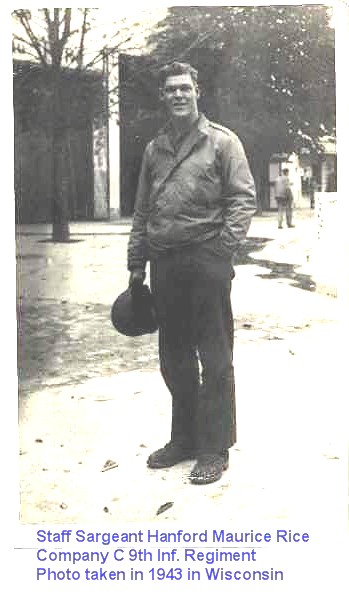 JUNE 1944
JUNE 1944
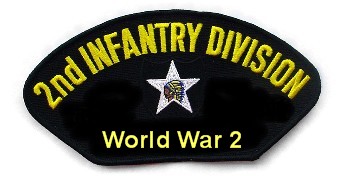
TREVIERES OFFENSIVE
(June 7-10, 1944)
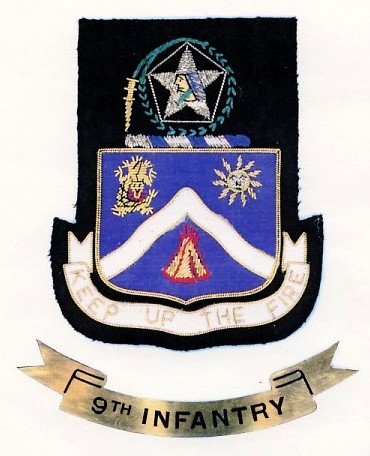 "In the Normandy campaign the Regiment fought at Saint Laurent-sur-Mer, Trevieres and Saint Germain d'Elle."
"In the Normandy campaign the Regiment fought at Saint Laurent-sur-Mer, Trevieres and Saint Germain d'Elle."

CERISY OFFENSIVE June 11-19, 1944
 Regiments, the division ploughed through Le Molay and the Foret de Cerisy until it struck
the first definite enemy defense line running west from Berigny through St. Georges d'Elle.
In two days, the division ripped overland 16 miles but had advanced 10 miles as the crow flies.
Regiments, the division ploughed through Le Molay and the Foret de Cerisy until it struck
the first definite enemy defense line running west from Berigny through St. Georges d'Elle.
In two days, the division ripped overland 16 miles but had advanced 10 miles as the crow flies.
"Spearheading the Second Division, the Regiment drove inland from the beach, cleared an
assembly area and in three days seized the entire Cerisy Forest."


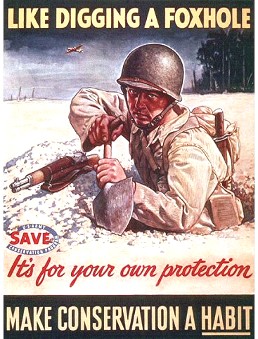 June 12, 1944 (Monday): "Digging in deeper on Powder Keg Hill. (Our front line is) Two
miles in front of everyone (else)."
June 12, 1944 (Monday): "Digging in deeper on Powder Keg Hill. (Our front line is) Two
miles in front of everyone (else)."

ST. GERMAIN D'ELLE, ST. GEORGES D'ELLE, LE PARC DEFENSIVE
June 20-July 10, 1944
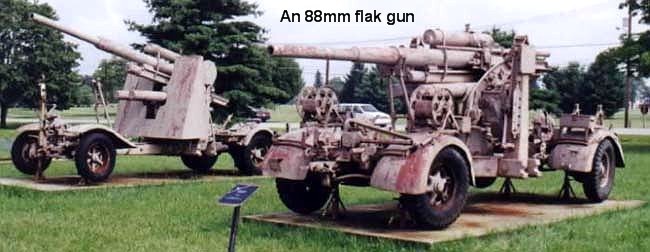
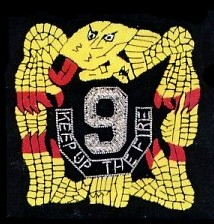
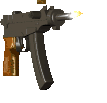 June 26, 1944 (Monday): "We build a barbed wire entanglement between our OP and front
line. (An enemy) flare (at night came down) and hit me (landed) on my back."
June 26, 1944 (Monday): "We build a barbed wire entanglement between our OP and front
line. (An enemy) flare (at night came down) and hit me (landed) on my back."

The Combat Infantryman's Badge (issued for being in combat)
HILL 192 OFFENSIVE July 11-12, 1944
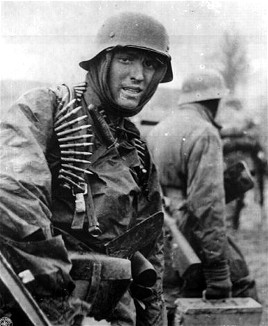

 It was the engineers' job, once they had blown openings in the hedgerows, to guide the tanks
to good firing positions. Telephones were attached to the rear of each tank but they failed
to operate. Pvt. Alton N. Jones, 2nd Engr. Bn., was one of many engineers who sought to
remedy the situation. Exposing himself to enemy fire, Jones crawled atop one tank and gave
directions by tapping on the hull.
It was the engineers' job, once they had blown openings in the hedgerows, to guide the tanks
to good firing positions. Telephones were attached to the rear of each tank but they failed
to operate. Pvt. Alton N. Jones, 2nd Engr. Bn., was one of many engineers who sought to
remedy the situation. Exposing himself to enemy fire, Jones crawled atop one tank and gave
directions by tapping on the hull.
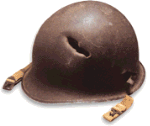
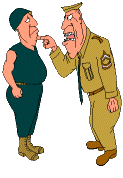 August 5, 1944 (Saturday): "Got replacements. Got bedding rolls. Had mail call.
(We) thought we were relieved for good."
August 5, 1944 (Saturday): "Got replacements. Got bedding rolls. Had mail call.
(We) thought we were relieved for good."
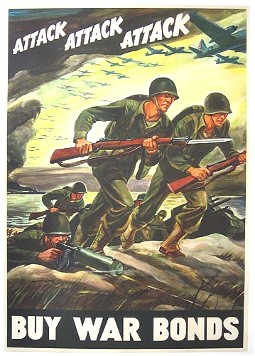
TINCHEBRAY OFFENSIVE August 8-16, 1944
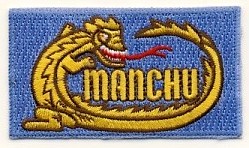 "For 59 days the Ninth Infantry was in line without relief. When a respite did come it was
only a brief one. From Vire the Regiment was sent to Brittany to take part in the Brest campaign."
"For 59 days the Ninth Infantry was in line without relief. When a respite did come it was
only a brief one. From Vire the Regiment was sent to Brittany to take part in the Brest campaign."


Links
![]() Click here to go to part 2 of his war diary
Click here to go to part 2 of his war diary
![]() The U.S. Second Infantry Division in World War Two
The U.S. Second Infantry Division in World War Two
![]() Thomas M. Rice- Killed in Action in Early Texas in 1842
Thomas M. Rice- Killed in Action in Early Texas in 1842

Articles on Spiritual Salvation

How to Live as a Christian Believer
Click here to go to the master index page
